The perfectly imperfect science behind a homegrown wedding
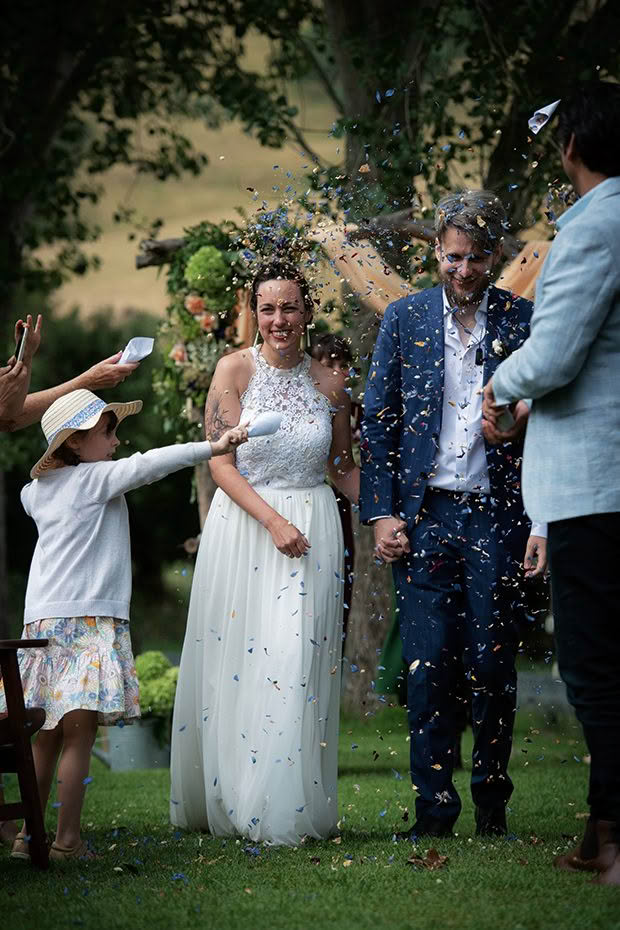
It’s hard to get a wedding perfect, but according to a family who created a beautiful, rustic-themed celebration on their Nelson lifestyle block, it doesn’t need to be.
Words: Michael Andrew Photos: Wedding guests
WHO: Amanda, Dónal, Rachel, Murray and David Brydon
WHERE: Nelson
WHAT: Lifestyle block
LAND: 3.1 Hectares
In spring 2022, six months before she was to host her daughter’s wedding on her Nelson property, Rachal Brydon started growing flowers.
She began by digging up the border of the driveway and planting it out with roses, dahlias, and echinacea. She then began sowing around 20 punnets worth of annual flowers that would be used to make the wreaths, the archway garland, the bouquet, and other decorations.
Then it was time to prepare the “venue”. She moved the sheep off the front paddock, which would be the site of the ceremony and party, and started mowing it with a push mower every week. She also continued tending her thriving vegetable garden, which would be the gathering space when the guests arrived.
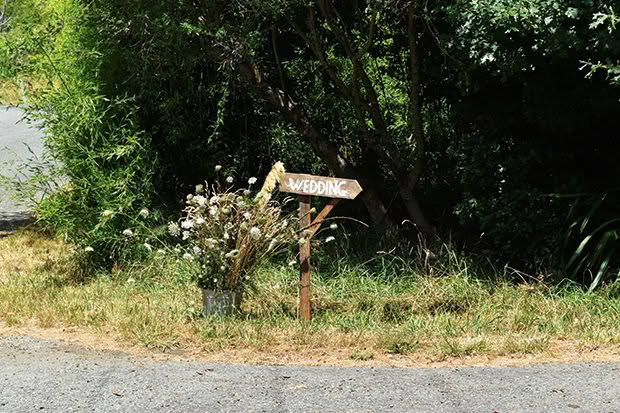
As the big day got nearer, she began sewing the fabrics for decorations while her husband, Murray, started crafting the woodwork – coasters, picture frame props, signs, and cake stands from tree stumps – including one with a horseshoe welded on it.
By the morning of the wedding in late January, the front paddock of Rachel and Murray’s lifestyle block was a spectacle of colours and creations: flowers in full bloom, a hay bale couch, a rustic cocktail bar, vintage furniture, and countless sylvan crafts and curios, made by hand with timber from around the property.
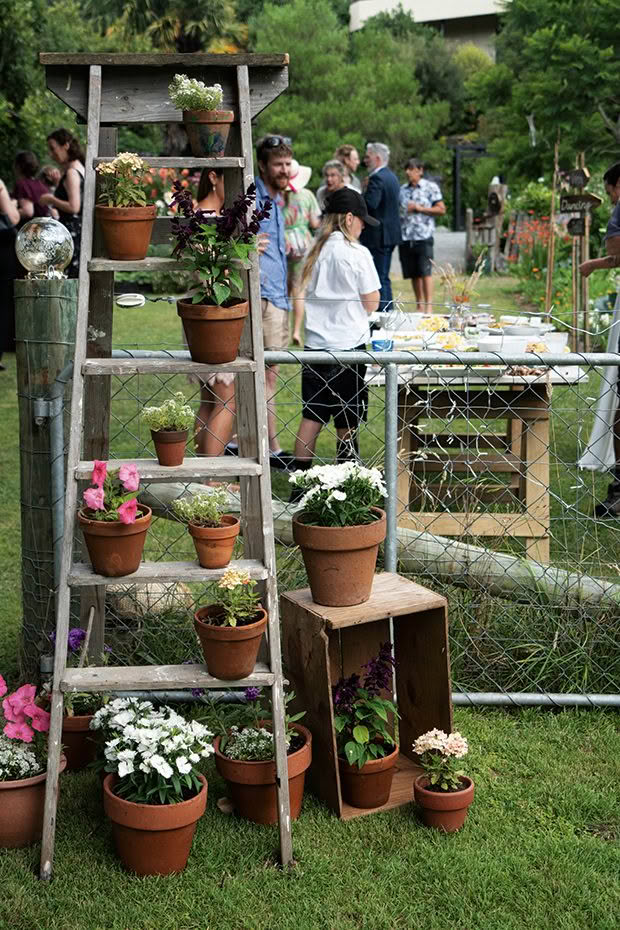
Wedding prep can be a stressful situation even in the best circumstances, and not many families have the time, energy or skill to create most of the props and decorations from the resources of their land. But if the Brydons know how to do anything, it’s DIY.
That, and have a good time.
“I love it!” says Rachel. “I was happily busy. We had a lot of fun – there was a lot of laughing during the preparation.”
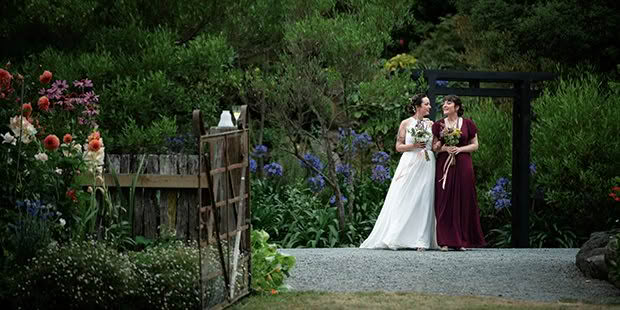
The bride, Amanda, walking down the “aisle” with her bridesmaid Sara and their homegrown bouquets.
If the wedding decor seems like it fits a deliberate rustic, rural theme, that’s because it did. While Murray and Rachel were putting together the bits and pieces in the months leading up to the wedding, the inspiration came from Amanda – the daughter and bride-to-be – who was overseas at the time but in the process of moving home for the wedding and to live at her parent’s block with her Irish fiancé, Dónal.
“All the creative ideas came from Amanda,” says Rachel. “The lovely thing about it being your child’s wedding is that all the decisions are theirs. We just said ‘what would you like?’ And they told us and we did it. Amanda would show me a picture on Pinterest of bunting and say ‘can you make this’? and I did.”
“Mum and I had had a lot of conversations about what the wedding could look like and what I was envisioning,” adds Amanda. “It felt quite relaxed and it was easy to visualise. I think the theme of rustic, relaxed outdoor wedding really just meant you didn’t have to make it perfect and it didn’t have to look perfect. It was just about the vibe of having friends and family and having a nice day.”
COMMUNITY SPIRIT
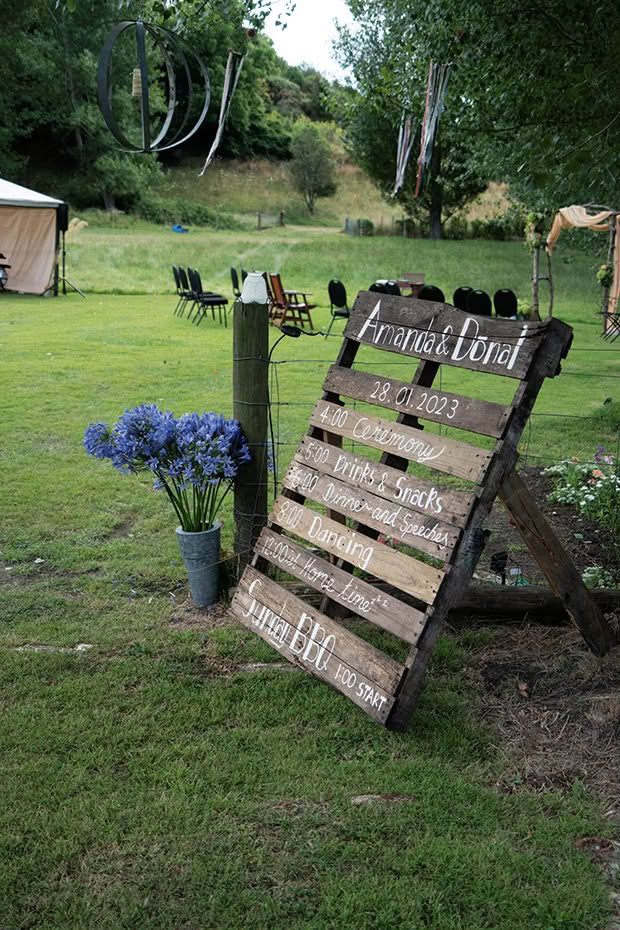
Taking nothing away from the sheer talent and devotion of Rachel and Murray to create what was, frankly, the setting for a dream wedding, they would have struggled to pull it off without the support of the people around them.
Blessed with an extensive community of loyal friends from Kaitaia and Nelson – their former and current hometowns – they were able to divvy out jobs during the preparations and on the day. This freed them to perform their dedicated tasks: Rachel sewing, gardening, cooking and baking, Murray crafting, shooting and butchering the sheep, and brewing his signature sparkling feijoa wine.
Rachel says having the help of friends was absolutely essential. One of her friends regularly sent down fabrics from the emporium in Auckland for her to sew into napkins and other decorations, while others were more than happy to loan or gift items.
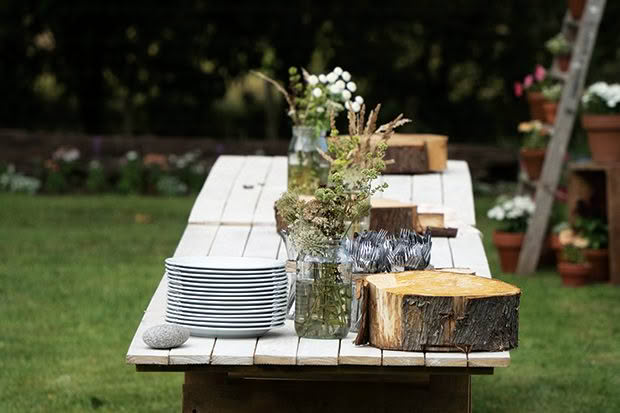
“We had a tight bunch,” she says. “There was a crew of old family friends, they came and helped us with all the heavy lifting, setting things up. But I stayed out of it – I was doing the food.”
She says she had half a dozen women with her in the kitchen for two days before the wedding. “I couldn’t have done it without them. I baked seven cakes the day before the wedding, and they cleaned all the dishes and greased all the pans, and they did the canapés on the day. We had other friends who did the serving and catering on the day, putting the food out and taking the plates away. So that was lovely.
“Without help, you’d have to hire a catering company. You have to be absolutely realistic. Murray and I could have done any one of those tasks but you can’t do them all simultaneously. So you’ve got to have help.”
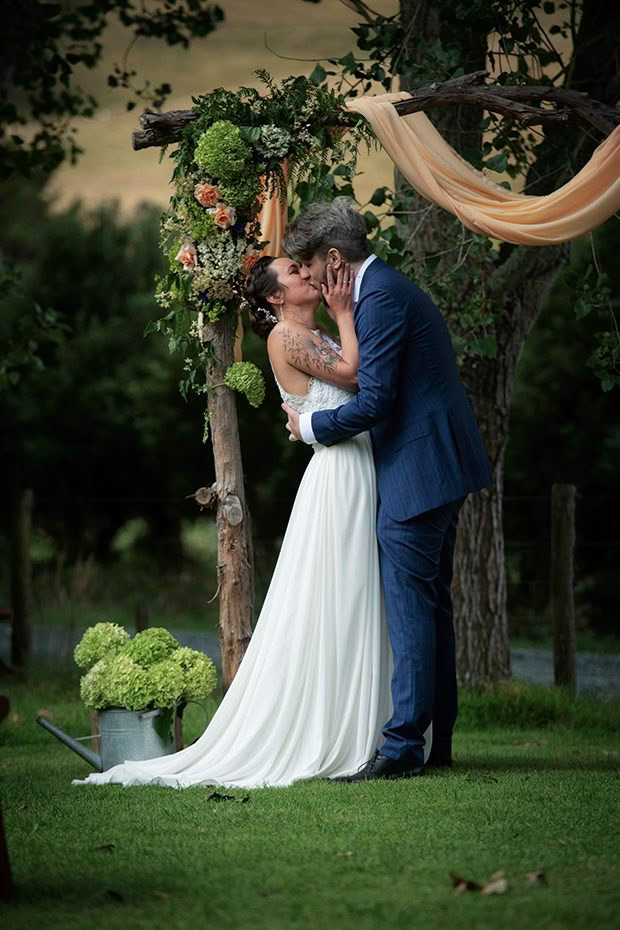
Along with providing the ideas and organising helpers, one of Amanda’s key jobs once she returned to NZ was to visit op shops and craft stores in Nelson to find secondhand goods and crafts that Murray and Rachel could use to create the wedding theme.
“I had a lot of fun looking at Facebook marketplace or going down to the refuse station collecting hodgepodge glasses,” Amanda says. “I went into Spotlight so much I struck up a friendship with one of the ladies who worked there. She was an artist and a hoarder and had a whole bunch of stuff. Me and Dónal were able to go around to her house and pick out a whole bunch of things like the typewriter and a wagon wheel and a lantern and a rustic table. So it just made it a lot more fun and personal.”
RAIN AND FLOODS
On the morning of Amanda and Dónal’s wedding, everything was falling into place. The few expensive items that needed to be rented, such as the marquee, spit and the chiller for the food and drinks, had been set up, while the family and their team of “fantastic helpers” roamed around hanging decorations and putting the finishing touches on the tables.
But if there’s anything that’s likely to complicate an outdoor wedding, it’s the weather. The day before, Auckland had been inundated with a summer’s worth of rain in less than 24 hours. Roads were washed out, hillsides had collapsed, and the airport runway was underwater. All flights to and from the airport were cancelled, and Amanda realised at least 12 guests – including the photographer (a family friend) – would not make it.
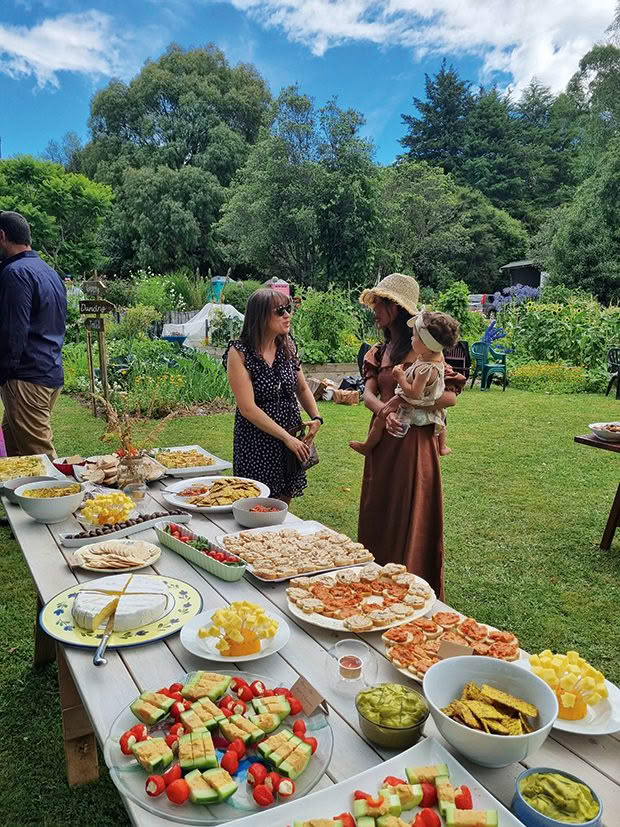
Guests in Rachel’s garden.
At most weddings, a missing photographer and a handful of important guests – including a key speaker – is usually a trigger for at least a little stress. After all, people usually invest many thousands of dollars into their special day, attempting to curate the perfect, blemish-free experience through a number of essential components. A photographer is near the top of the list.
But Amanda had deliberately designed the wedding, and her expectations of it, to be flexible. Disappointed, but not dismayed, she and her family did what they’d done the whole time – they adapted. They put out the word for a local photographer, but in the meantime they decided they would ask guests to take as many photos as they could on their phone cameras – much like people used to do with polaroid cameras at weddings. “Everyone’s got such amazing phones these days – they all pitched in,” says Amanda.
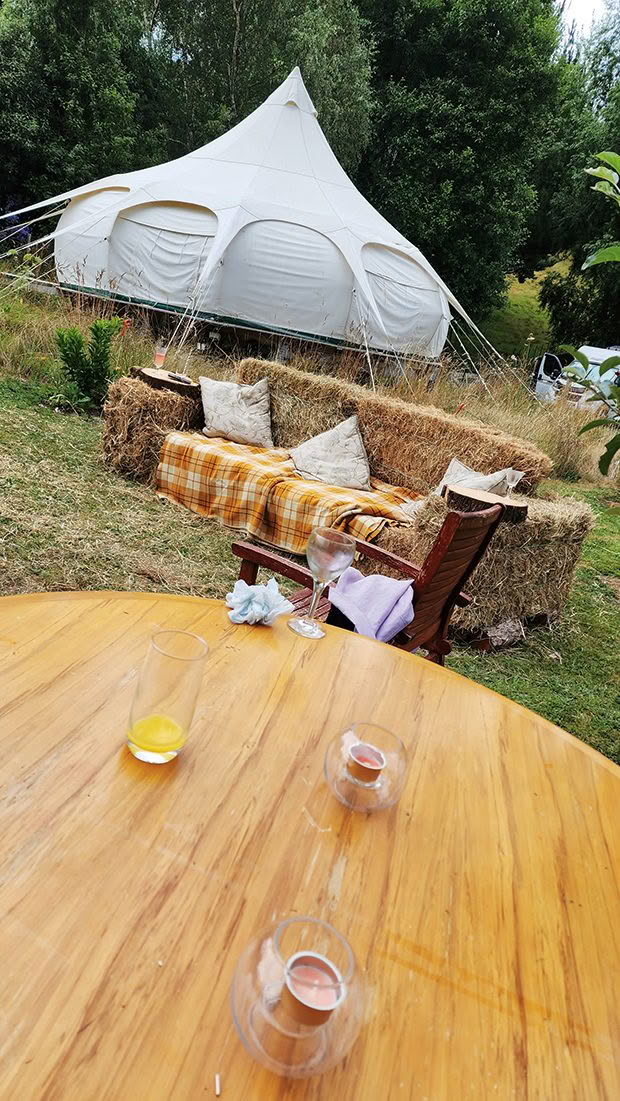
The haybale couch – which Amanda fed to her horse afterwards. The “fantastic helpers” setting up the bunting and decorations on the day.
And although the sky often threatened to rain, Rachel says they had a contingency plan for that as well.
“Our local community hall – which is council-run and where we borrowed the tables, chairs and crockery for a small donation – we booked as a backup in case the weather turned nasty and we had to do it all inside.”
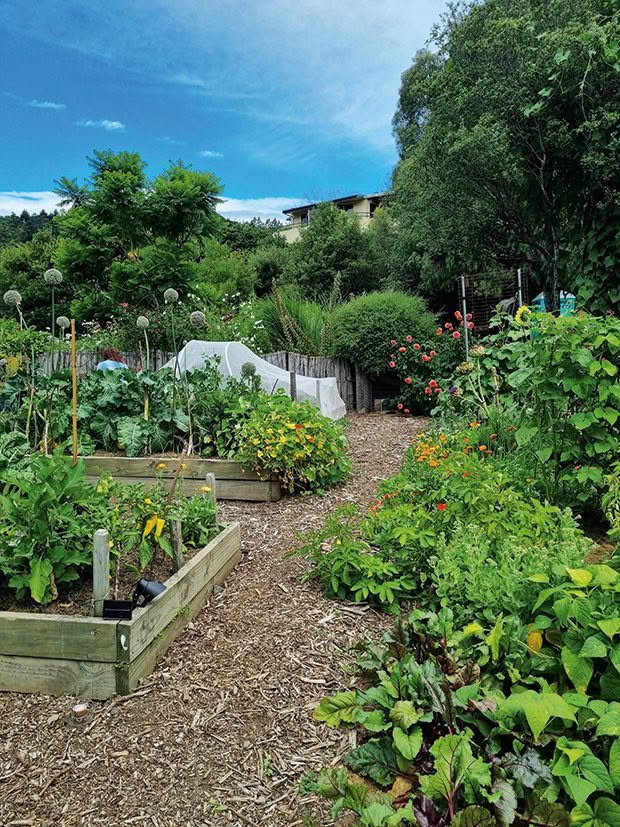
“I think the one bit of stress was around the weather,” Amanda adds. “There was definitely a contingency plan – it wouldn’t have been exactly how we envisaged but the hall was close and the main thing was just about getting the people in the room and having good food and good drinks.”
Knowing that, like any wedding, there are likely to be many unexpected obstacles and things might not go exactly as planned, Amanda took a pragmatic perspective that allowed her to approach any disruptions and difficulties with a calm mind.
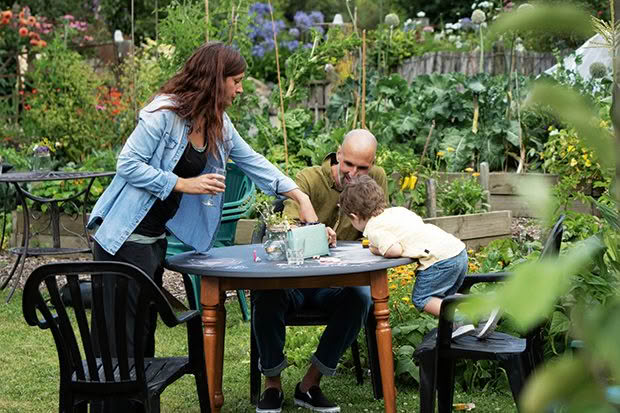
“I had an attitude of ‘I got myself into this – if things are busy, or I’m having to put in a lot more effort than I thought, I’ve got no one to blame but myself.’ So I think that that approach is quite good for mental health and resilience.”
For example, she says, it rained on the Friday, which meant many of the decorations and furniture couldn’t be put out until the morning of the wedding. “So my vision for having everything looking beautiful the night before, and then waking up and having a leisurely breakfast didn’t quite happen,” she says, laughing.
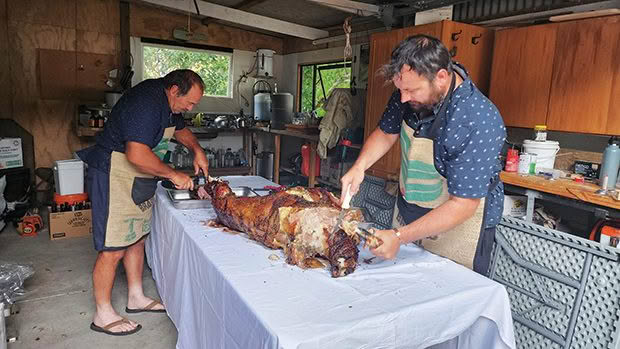
Family friends preparing the homekill sheep.
From 7am to midday on the morning of the wedding, Amanda was down at the venue directing people, and trying to teach Dónal how to tie knots to hang up the bunting. “He’s not a knot man!” she says.
“In reality, there was a lot more work than the vision of me being the bride and waking up and being waited on hand and foot. But once 12pm hit, I was able to come up to the house and have a shower, and the hairdresser turned up and the bridesmaid put a glass of prosecco in my hand.”
THE WEDDING
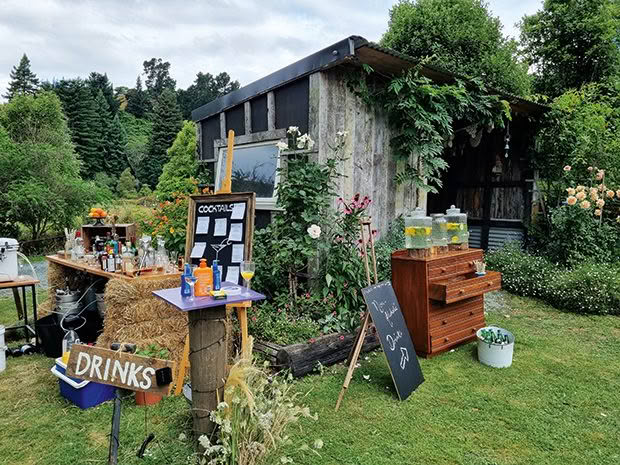
The make-your-own cocktail bar, where the guests demolished Murray’s feijoa wine (the recipe is a trade secret).
When the guests arrived on the afternoon of the wedding, the sun was shining and moods were high. Despite those who couldn’t fly from Auckland, there were still over 70 people who had managed to make it from all over the country, and a few from as far away as Paris. They sat in Rachel’s garden, made good use of the make-your-own cocktail bar, and swilled Murray’s excellent feijoa wine as gentle jazz melodies drifted over the paddock. “We were incredibly fortunate to have professional musicians the Jackson Duo as neighbours and friends to play gentle melodies as the guests chatted and for the ceremony itself. It went a long way to creating a lovely atmosphere.”
Although the ceremony was originally scheduled for 4pm, they pushed it back to 6.15pm to give any Auckland guests more time to make it, just in case flights resumed. With a few hours to spare, both Amanda and Dónal decided to come down and mingle with the guests, rather than keep to the conventional wedding format.
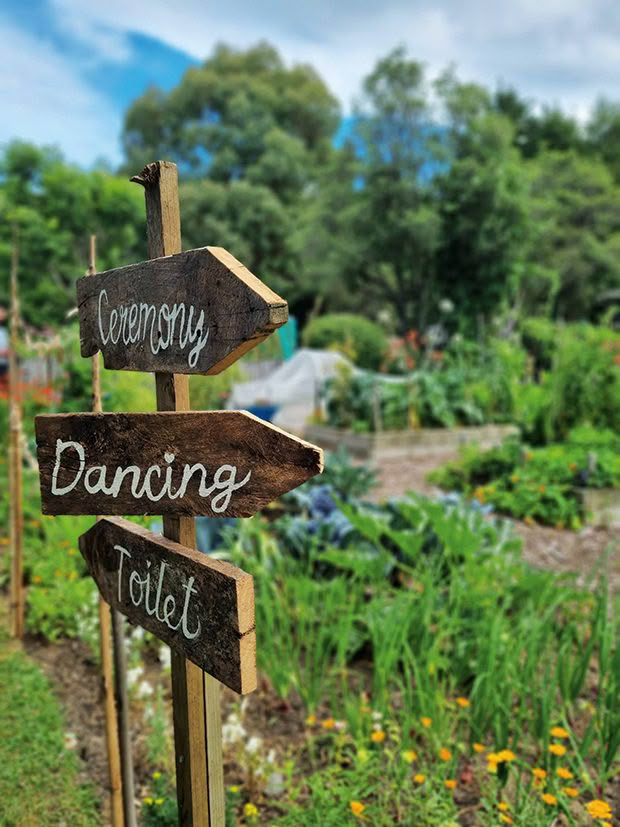
“Being able to come down early at 4pm and mix and mingle and see the guests was fantastic,” says Amanda. “We were so much more relaxed for the ceremony, rather than worrying about people seeing my dress early. I think not having that traditional format and focusing on what’s fun and what we want to do really makes the event. It doesn’t matter what time it is or what order things go, as long as you’re enjoying yourself.”
Just as the ceremony began, two taxis arrived carrying guests who had managed to make it out of Auckland on afternoon flights – including one of the speech givers. It also happened that the son of the musicians – a professional photographer – was passing through on the way back from Blenheim. He called in, and suddenly the wedding had a photographer.
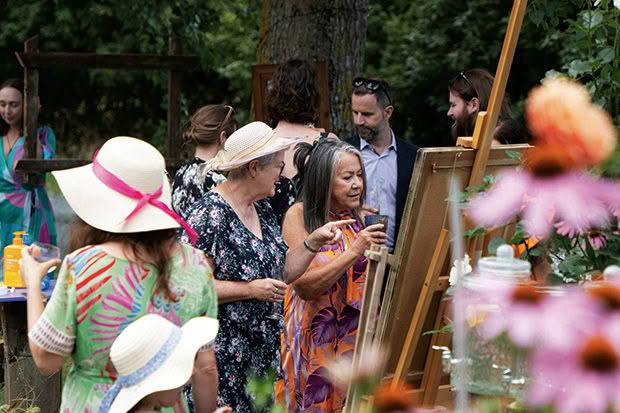
Much like everything else at the wedding that day, the ceremony was magic. The rain held off, and Dónal and Amanda were married on their parents’ lifestyle block, and their new home, underneath the flowers her mother had grown and the archway that had been put together by her father with kānuka branches. Amanda’s brother David read a poem, while he and his wife Kelly were the witnesses and their two children were the ring bearers.
With the ceremony over, it was time for dinner and speeches. Rachel and her entourage rolled out the banquet several days in the making, while Murray brought down the homekill hogget that he had shot, butchered, and cooked on a spit. After the feast, the plates were cleared, the tables were moved and it was time for the party. For Rachel, who’d run up and down the 40 steps from the venue to the house several dozen times that day, it was finally time to relax.
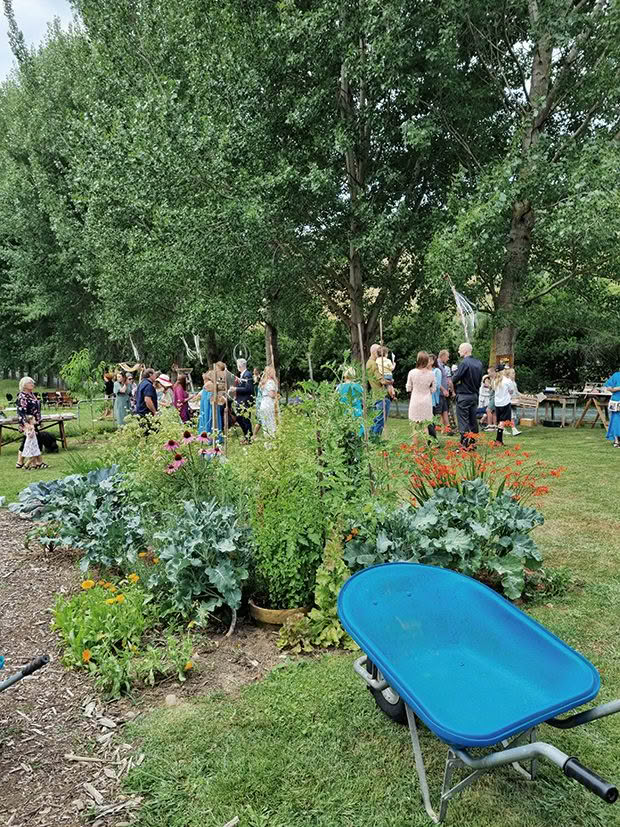
“I was wearing good shoes too!” she says. “I went and sat in the shed later that evening for 10 minutes and promptly opened a bottle of champagne. Then I realised it was a wedding gift for Amanda and Dónal, so I quietly replaced it in the morning!”
The day behind her, this was the time for Amanda to fully let go of all the event planning and organising, and embrace the revelry with her new husband, while catching up with people she hadn’t seen in six years of living abroad.
She could relax and take a deep breath, knowing that the worst thing to have happened that day was the guests overpouring campari thinking it was cranberry juice. If any other issues might happen that evening, she knew she had an “army of competent people” to handle it.
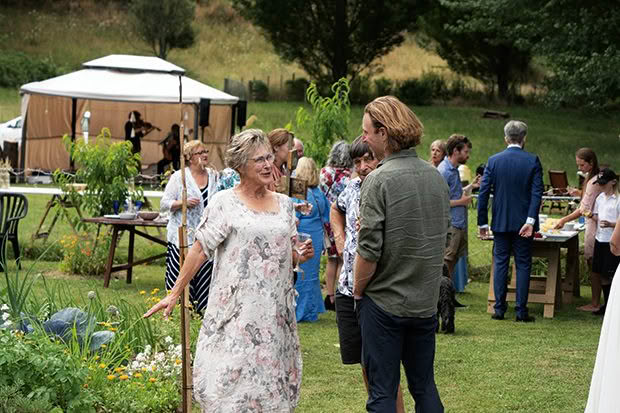
Rachel taking a moment to have a drink and a chat in between wedding duties.
But despite the immense contributions of family and community, perhaps the most special part about this wedding was the property itself. Unlike many other weddings that take place in commercial venues where the bride and groom are guests like everyone else, Amanda and Dónal were at socialising and celebrating on family land – their new home.
“Just knowing how much Mum and Dad love to host people, and also just being able to invite people to where Dónal and I will be making a home in New Zealand and putting down roots – it made it a lot more personal.
“It’s about the people you interact with, as opposed to just what happens on the wedding day. Bringing people together to have a good time – that’s what you remember.”
BACKYARD WEDDING TIPS
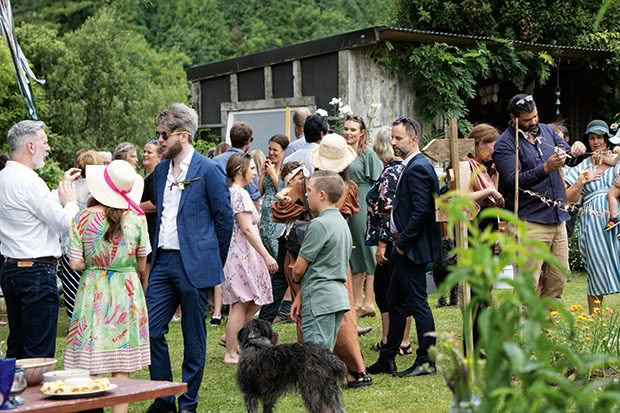
Guests mingling before the ceremony.
Because DIY home weddings require a lot more organising than a wedding at a fully-serviced venue, it pays to have certain strategies for the day and during the preparation. Here are the Brydons’ top tips for a low-stress, affordable wedding:
1. Organise your help well. To prevent a case of “too many chefs” Rachel says you want to have small numbers of the right people you know well, rather than accepting help from everyone that offers. Select people who can follow instructions, rather than those who do a task themselves. While friends love to volunteer, the Brydons’ made donations to charities of their helpers’ choices in exchange for the work.
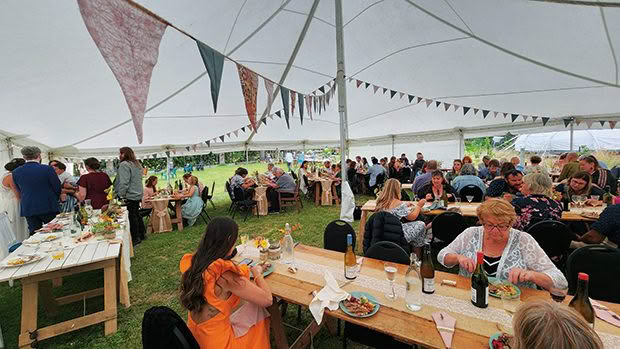
Other than the chiller and spit, the marquee was the largest expense and was the site of the dinner and party – Amanda says if she could do one thing differently, it would be having set seating, which would encourage guests to mingle with those they don’t know.
2. Focus on only a few “important” areas. “If you try perfect everything, you’ll spend a fortune,” Amanda says. Select two or three elements that are important to you and let the rest fall into place. For Amanda, it was the crafts and people, whereas a band, expensive photographer and a fully catered sit-down meal were off the cards.
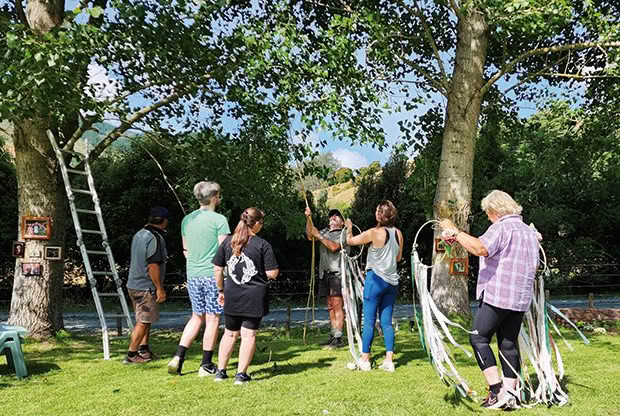
3. Logistics and guest comfort. It’s wise to have the option of a car even on a lifestyle block to transport goods between the various parts of the wedding i.e the house/kitchen and the venue. Ensure there’s plenty of shade and plenty of seating, as it is very easy for guests to overheat at an outdoor wedding.
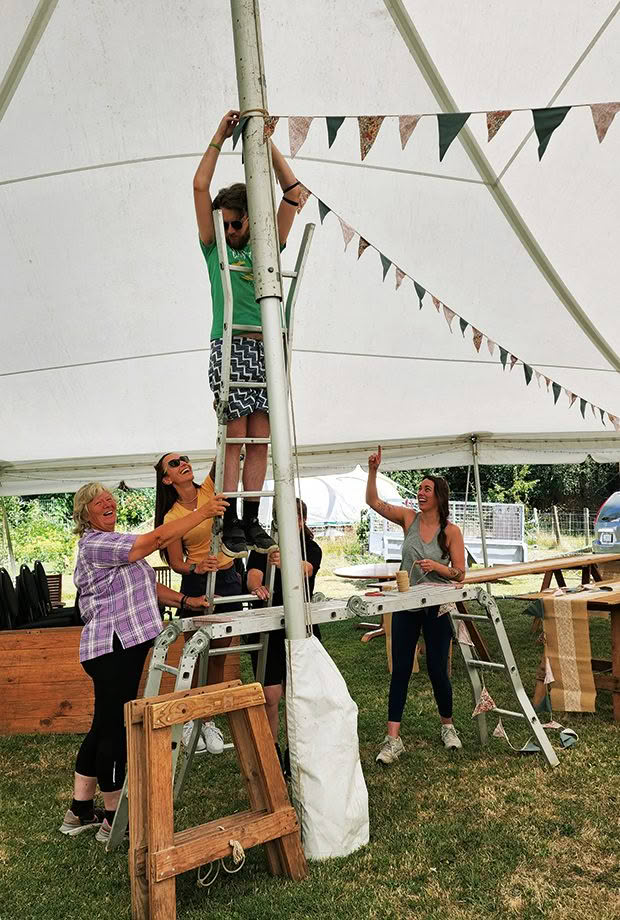
The “fantastic helpers” setting up the bunting and decorations on the day.
4. Use secondhand goods. Along with reducing waste, buying or repurposing secondhand goods keeps costs down. It also makes it easy to let the materials go, rather than keeping them in storage. “Being able to see the stuff that I got going back on Facebook Marketplace and for someone else’s special day and making them happy, it’s been really nice,” says Amanda.
Love this story? Subscribe now!
 This article first appeared in NZ Lifestyle Block Magazine.
This article first appeared in NZ Lifestyle Block Magazine.
